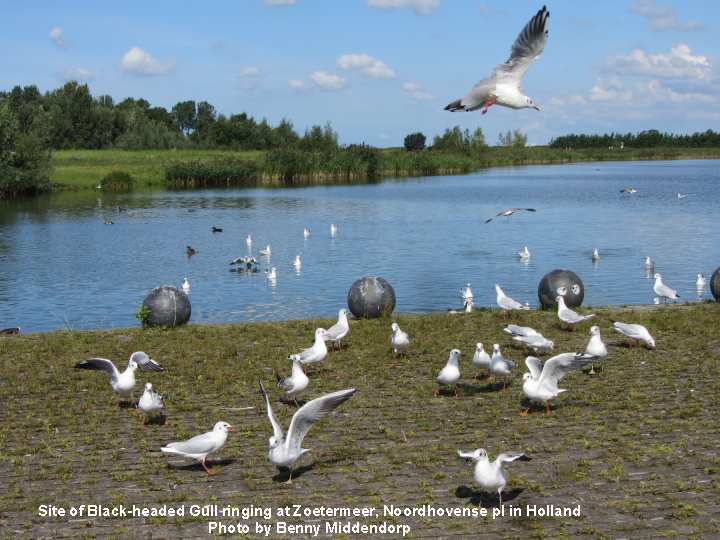RETURN
TO . . .
Emsworth
Wildlife - Homepage
EMSWORTH'S
MILLPONDS
Emsworth has three
millponds as shown in the map below.
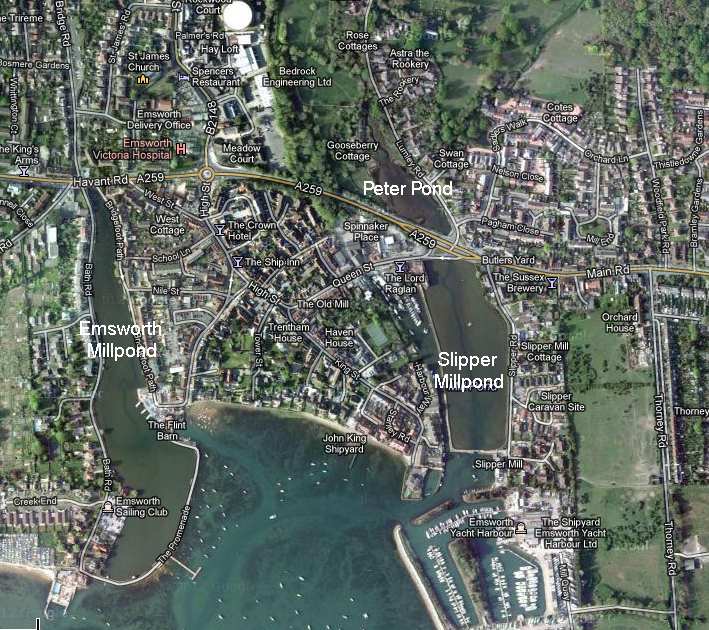
The two eastern
millponds have a more natural habitat than the town
millpond, with reedbeds and bankside vegetation.
Peter Pond - is owned
by the Kinloch family and is managed by David
Gattrell.
Go to . . . Peter
Pond
Slipper Millpond - is
owned by the Slipper Millpond Preservation Society who
also manage its banks and sluices.
Go to . . . Slipper
Millpond
Emsworth Millpond - to
the west of the town is usually referred to as
Emsworth Millpond or simply the town millpond. It is
owned by Havant Borough Council. Here are more details
about this pond.
EMSWORTH
MILLPOND
Emsworth Millpond was
originally a tidal inlet. Now the Westbrook Stream
drains into the pond through a culvert under the A259
road from the north. Nowadays a remotely controlled
sluice controls the opening of the millpond to the
tide. The pond is flushed out every month and the
sluice is also opened when flooding is
threatened.
The town millpond has
little in the way of natural vegetation, but the birds
are well fed by locals and visitors. Feeding the ducks
is a popular pastime. We encourage people to feed seed
to the birds rather than bread, which contains salt
and is not really very good for them. However, most
people do feed bread to the birds and they do not
appear to have suffered too much. The Westbrook Stream
which flows into the millpond from the north, brings a
regular flow of small fish which attract diving birds
and gulls.
A
view of the millpond looking north from the harbour
wall
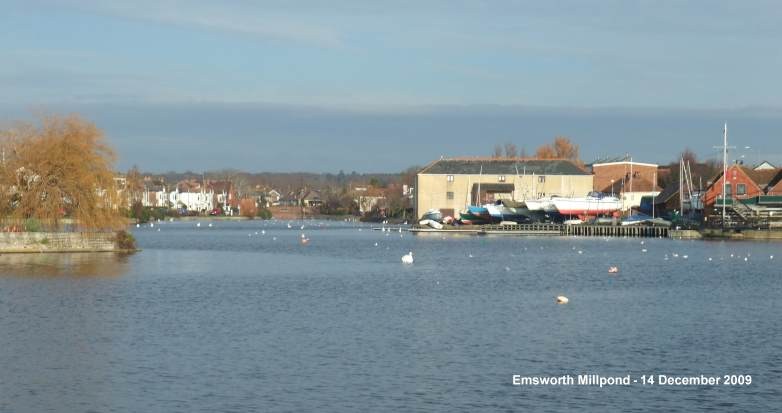
BIRDS
RECORDED ON THE MILLPOND SINCE 1990
Updated
May 2011 . . . . N = 40
|
.
|
STATUS
|
|
SWANS
|
.
|
|
Mute
Swan
|
Common all year. Max
135 July 2001
|
|
Polish'
Swan
|
Occasional on pond
(Pink legs and feet)
|
|
Black
Swan
|
Occasional visitor
for periods
|
|
DUCKS
|
.
|
|
Mallard
|
Common all year.
More in winter. 100+
|
|
Tufted
Duck
|
Regular in winter.
Max 74 - Jan 8 2011
|
|
White Domestic
ducks
|
Regular all
year
|
|
Buff Orpington
Duck
|
Two males on
millpond Sep-Oct 2010
|
|
Pochard
|
Occasional winter
visitor
|
|
Goldeneye
|
Occasional winter
visitor
|
|
Mandarin
|
Rare winter visitor
- 1996
|
|
Red-crested Pochard
|
Rare winter visitor
- 2000
|
|
Muscovy
Duck
|
Rare winter visitor
- 2008
|
|
GEESE
|
.
|
|
Canada
Goose
|
Occasional
visitor
|
|
Snow
Goose
|
Rare winter visitor
- 1992
|
|
Greylag
Goose
|
Rare winter visitor
- 1997
|
|
Brent
Goose
|
Rare winter visitor
- 27-Nov-94
|
|
Barnacle
Goose
|
Rare winter visitor
- 1997
|
|
Bar-headed
Goose
|
Rare winter visitor
- 1997
|
|
Emperor
Goose
|
Rare winter visitor
- Last in 2000
|
|
RAILS
|
.
|
|
Coot
|
Common all year.
More in winter.
|
|
GULLS
|
.
|
|
Black-headed
Gull
|
Common all
year
|
|
Common
Gull
|
Regular in
winter
|
|
Herring
Gull
|
Regular in
winter
|
|
Lesser Black-backed
Gull
|
Occasional in
winter
|
|
Great Black-backed
Gull
|
Regular in
winter
|
|
Mediterranean Gull
|
Occasional in
winter
|
|
Yellow-legged Gull
|
Rare winter visitor
- Last in 1999
|
|
HERONS
|
.
|
|
Little
Egret
|
Regular in winter
when pond is low
|
|
Grey
Heron
|
Regular in winter
when pond is low
|
|
Spoonbill
|
Once only on
12-Dec-02
|
|
CORMORANTS
|
.
|
|
Cormorant
|
Regular in
winter
|
|
GREBES
|
.
|
|
Little
Grebe
|
Regular in
winter
|
|
Great Crested Grebe
|
Regular in
winter
|
|
SAWBILLS
|
.
|
|
Red-breasted
Merganser
|
Regular in
winter
|
|
Goosander
|
Rare winter visitor
- Last in 2000
|
|
TERNS
|
.
|
|
Common
Tern
|
Occasional in
summer
|
|
Sandwich Tern
|
Occasional in
summer
|
|
WADERS
|
.
|
|
Redshank
|
Occasional when pond
is low
|
|
Lapwing
|
Occasional when pond
is low
|
|
Dunlin
|
Occasional when pond
is low
|
|
Ringed
Plover
|
Occasional when pond
is low
|
|
Bar-tailed
Godwit
|
One sighting - 11
May 2011
|
BIRDS
OF EMSWORTH MILLPOND
The pond is home to
resident flocks of non-breeding Mute Swans,
usually in the region of 50, though occasionally
rising to over 100. Pairs of Swans have attempted to
nest on the pond, though in the absence of natural
materials they have to build their nest from litter
and are rarely successful in raising young.
'Polish' swans
can also be seen on the pond. As cygnets their
plumage is white, unlike the brown plumage of regular
cygnets. As adults they can be detected by their pink
legs and feet. The regular swans have black legs and
feet.
Here
is one probably from a brood on Peter Pond in
2004
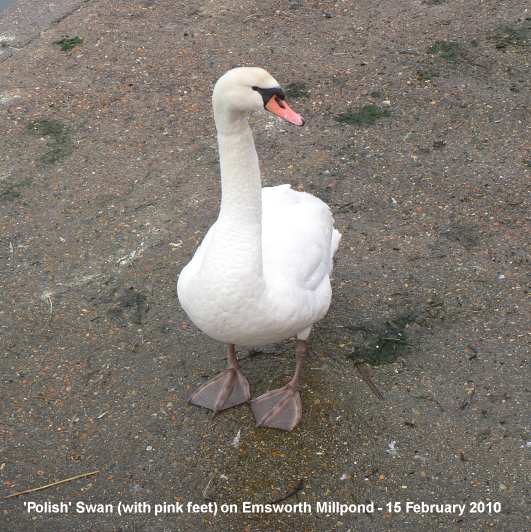
A Black Swan
has visited the town millpond on a number of
occasions over the years. The earliest record I have
is of one on the millpond from September 1992 to
February 1993. Another was resident on the millpond
for three years from February 1999 to March 2002. The
next one I know about arrived in August 2004, though
that did not stay long. Further short visits were made
in June 2006 and January 2008. Black Swans actually
breed on West Ashling pond and it seems likely that
the more recent of our visitors will have come from
there.
Here
is the Black Swan that visited in 2004
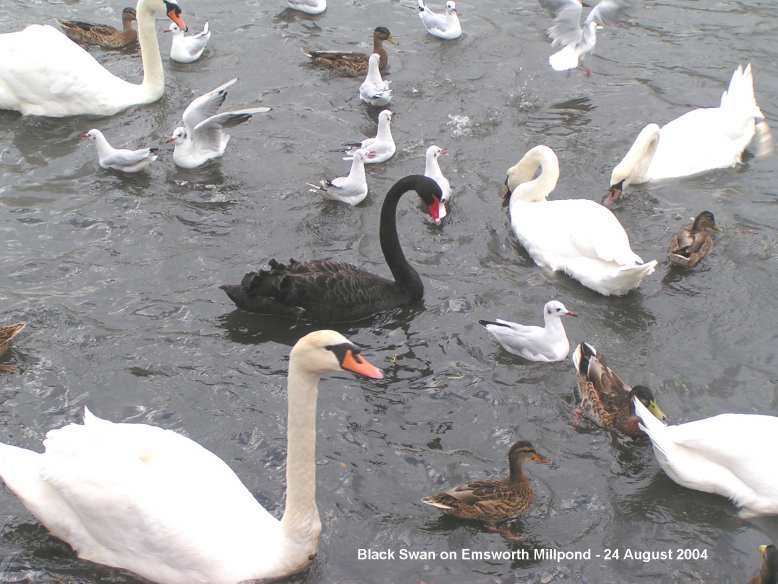
Mallards are
also present on the millpond all the year round,
usually around 100 in number, sometimes more in
winter. There are usually a few hybrid ducks and white
domestic ducks on the pond, though they are difficult
to identify.
Tufted Ducks
are regular winter visitors, usually arriving in
October with numbers building up to 30 or so as the
winter progresses. The cold winter of 2010-11 saw an
unprecedented invasion of Tufteds onto the millpond
with 50-60 regular and high of 74 on January 8 2011.
Pochard and
Goldeneye are also occasionally seen on the
millpond, though they are not regular visitors.
Cormorant,
Little Grebe, Great Crested Grebe and
Red-breasted Mergansers are regular winter
visitors on the millpond. We also had a
Goosander on the millpond in Year 2000, but not
seen since.
Coot are also
resident on the pond, with more coming in the winter,
rising to about 20. A pair regularly attempt to nest
in the northern section of the pond, but the nest is
always swamped by the rise and fall of the water.
Geese are not common
on the millpond. Canada Geese occasionally turn
up, but not regularly. We have also seen Snow Goose,
Greylag Goose, Brent Goose, Barnacle Goose, Bar-headed
Goose and Emperor Goose, but not on a regular basis.
Grey Heron and
Little Egret are often seen on the pond,
particularly in winter and when the water is low.
The most famous
visitor was a Spoonbill which came onto the
pond on one memorable occasion on 12-Dec-02, but has
not been seen since.
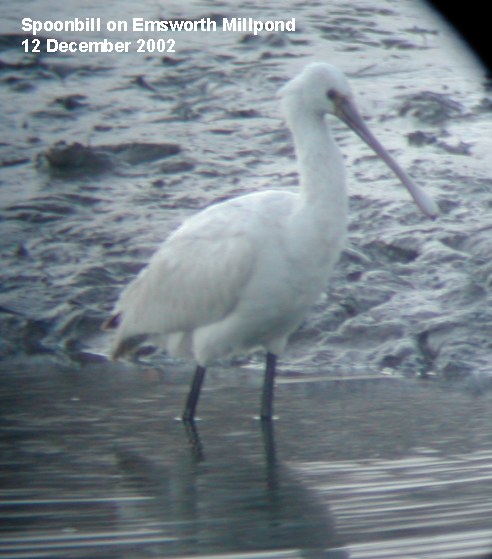
When the water is low
waders sometimes feed on the mudflats. Redshank
are the most common, though Lapwing, Dunlin and Ringed
Plover have been seen.
Kingfisher is a
fairly common sight in winter flashing low over the
pond.
Pied Wagtails
are another special feature of the millpond; up to
100 may be seen flitting around the millpond wall,
particularly at dusk. They must roost locally.
Black-headed
Gulls
Black-headed Gulls are
on the pond throughout the year, far more numerous in
winter. Many young 'gingery' Black-headed Gulls are
seen in early summer from the breeding colony in
Langstone Harbour. The gulls provide great
entertainment by catching food tossed into the air.
Other gulls are also regularly seen on the pond,
though in small numbers, including, Common Gull,
Herring Gull, Lesser Black-backed Gull, Great
Black-backed Gull and Mediterranean Gull. Sandwich and
Common Terns sometimes fish in the millpond.
About 100 Black-headed
Gulls are regularly on the millpond during winter.
They are attractive birds to feed as they will fly
acrobatically to catch bread tossed to them in flight.
Here they are on the eastern side of the town millpond
being fed with bread.
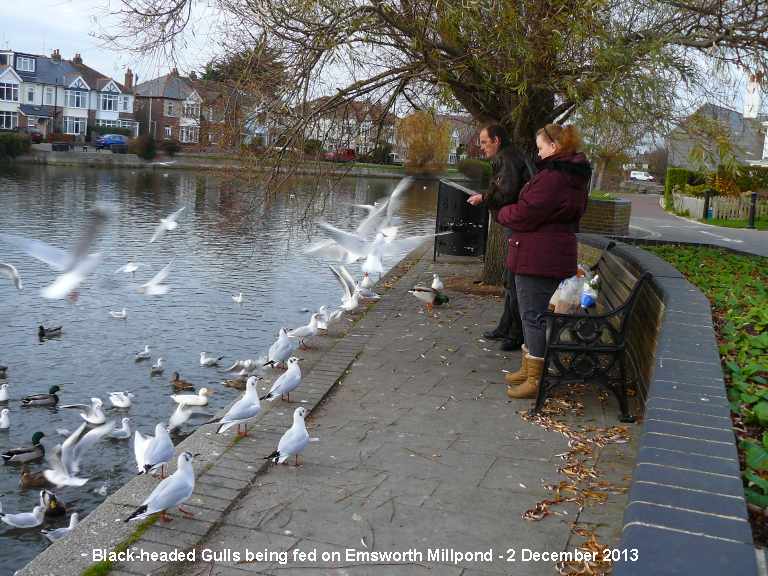
Ringed
Black-headed Gull
I noticed that one of
the gulls being fed had an engraved white ring on its
left leg. I could not read the ring as the birds were
constantly on the move, but took lots of photos and
got one showing the ring and the engraving. It was
EAS6. The right leg had a standard metal ring.
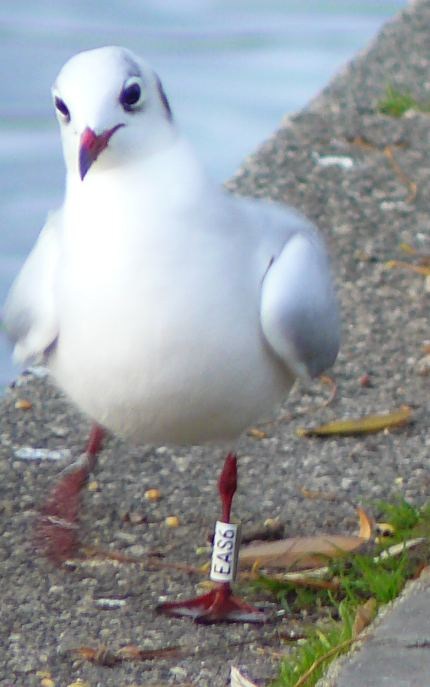
Reporting
the colour-ringed gull
I checked the European
colour-ringed birding web site to see to whom I should
report the sighting. http://www.cr-birding.org/
This led me to a Dutch birdwatcher ringer named Frank
Majoor to whom I e-mailed the sighting
details.
Frank's web site gave
lots of information about his ringing activities as
well as information about recoveries of his ringed
birds. Web site . . . http://www.frankmajoor.nl/
Apparently, most of the Black-headed Gulls which breed
in The Netherlands migrate south (Belgium, France and
Spain) or southwest (England and Ireland). So this one
was probably a Dutch breeder. Frank sent the following
link indicating the wintering destinations of the
gulls that breed in Holland. http://www.petervanhorssen.nl/kokmeeuw_brd/index.html
Ringing
information:
Bird was ringed by Benny Middendorp in Holland at
Zoetermeer, Noordhovense pl on 05-Mar-2012. Since then
it has been seen 9 times in Holland, all in the
ringing area and mostly by Benny. The last sighting
before today's was on 17-Jun-2013. Benny sent me this
photo of the bird in its breeding plumage with a
beautiful brown head.
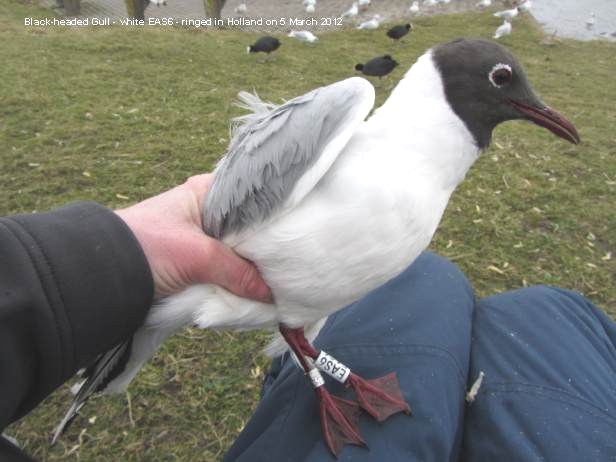
Benny tells me the
bird is a breeding bird from Zoetermeer,
Benthuizerplas which is east of Den Haag.
See picture with islands at . . . http://goo.gl/maps/LYXag
Here
is the site where the gull was ringed. Looks like home
from home?
